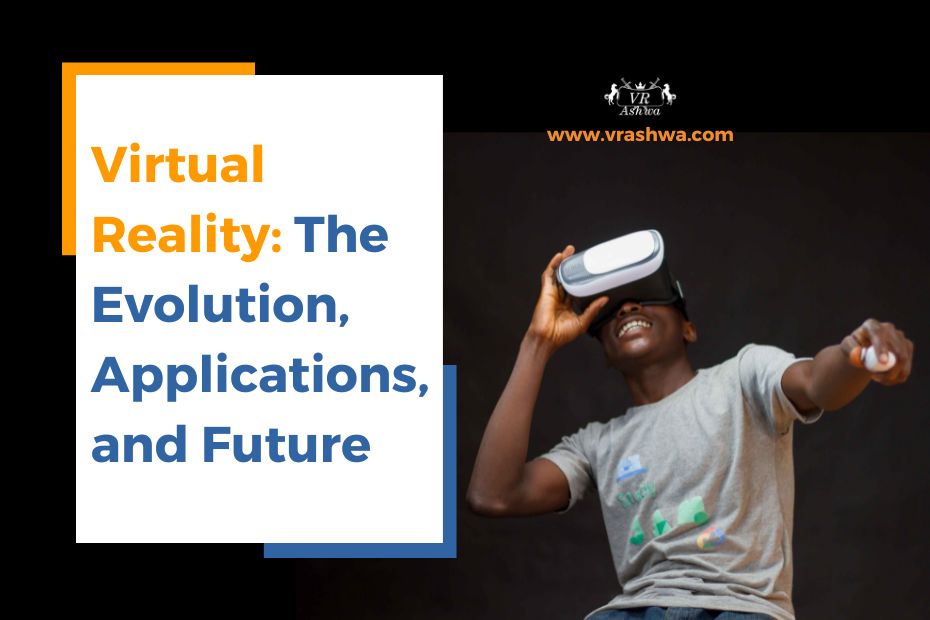Virtual Reality: The Evolution, Applications, and Future

Virtual Reality: The Evolution, Applications, and Future
Imagine walking through a museum without ever leaving your home. Or take a virtual trip to another planet. Or even try on clothes without ever leaving your bedroom. Welcome to the Virtual Reality (VR) world, where anything is possible.
XR is an umbrella term that encompasses Virtual Reality (VR), Augmented Reality (AR), and Mixed Reality (MR). These technologies allow users to enter a completely immersive experience that blends the real world with digital creations.
VR creates a simulated environment using head-mounted devices, handheld controls, and haptic devices. AR overlays computer-generated visuals onto the real world, often using AR glasses or a Heads-up Display (HUD). MR allows users to interact with their digital devices, blurring the line between the real and virtual worlds.
But what makes XR truly immersive is its Degree of Freedom (DoF), which determines the level of movement a user can experience. With 3DoF, users can move their heads in three axes, while 6DoF allows for a more excellent range of motion.
So, whether you’re exploring new worlds or just trying on a new outfit, XR is changing how we interact with technology and the world around us.
How Virtual Reality Evolved?
Extended Reality has come a long way since its introduction in the 1990s. At that time, VR was mainly used in arcade and console video games like Sega VR-1 and Nintendo Virtual Boy. However, these initial ventures were unsuccessful, and the XR world went quiet for the next decade.
The XR industry gained traction in 2010 with the creation of the Oculus Rift VR Headset. In 2014, the company was acquired by Facebook, bringing VR technology to the forefront. Google released Google Glass AR glasses and the more affordable Google Cardboard, a low-cost alternative to VR headsets.
In 2015, Samsung Gear VR was introduced in collaboration with Oculus, and HTC Vive was released, offering immersive virtual reality experiences. The following year, Microsoft released the HoloLens Headset, an AR device that projected holographic images into the user’s surroundings. Sony also released their VR headset, the PlayStation VR.
AR took the world by storm in 2016 by releasing the popular mobile game Pokemon GO. AR is often used with smartphones and smart glasses, but many wearable, handheld, projection, and tracking devices are also used for more specific purposes.
XR technology continues to evolve, with new and innovative devices being introduced to the market. With these advancements, we can only imagine the future of XR and how it will change how we interact with the world around us.
What are the Application and adoptions of VR?
Extended reality technologies have found a wide range of applications in various sectors. One of the most prominent examples of XR adoption is online shopping, which has seen a surge in demand during the pandemic. To address the challenges of customers who cannot physically experience the products they want to buy, brands like Ikea, Sephora, Apple, Nike, and L’Oreal have embraced AR and VR technologies. Ikea’s Augmented Reality App allows customers to see how furniture items would look and fit in their homes, while beauty brands use AR to let customers try out virtual make-up products.
In the real estate sector, XR has revolutionized how buyers view properties. Virtual tours provide a more immersive and interactive experience, allowing buyers to explore every nook and corner of a property without actually visiting it. Companies like Matterport and Zillow lead the way with their 360-degree digital capture and 3D home tool, respectively.
XR has also found applications in design, engineering, and construction, where it is used for modeling and projecting proposed projects. Companies like IrisVR can build immersive VR experiences from floor plans, enabling stakeholders to visualize projects before they are made.
One of the most significant achievements of XR technology is in healthcare. Virtual Reality Exposure Therapy (VRET) has been used to treat post-traumatic stress disorder (PTSD) with promising results. The Accuvein AV500 Vein Wipe has also made the work of nurses quicker and simpler by using AR technology to help locate veins.
What is the future of Virtual Reality?
In the field of medicine, the potential of XR is just beginning to be realized. Surgeons are already using VR and AR technologies for training purposes, and the remote control of robotic surgical instruments is also being made possible by XR. There is excellent scope for telemedicine, where doctors can conduct remote examinations and surgeries with the help of XR.
Education is also set to be transformed by XR. With immersive experiences, students can learn about historical events or science phenomena, take virtual field trips, and interact with realistic models of objects and organisms. This will make learning more engaging and help bridge the gap between theory and practical knowledge.
As for the entertainment industry, XR will take the gaming experience to a new level with more interactive and immersive games that blur the line between the virtual and the real world. XR will also revolutionize how we consume and produce media content with new forms of storytelling and immersive experiences that are not limited by the physical world.
Conclusion
Extended Reality has come a long way since the 1990s when VR was first introduced in arcade games. The XR industry is estimated to contribute $1.5 trillion to the global GDP by 2030. XR has transformed how we live, work and interact with the world around us.
Online shopping has been revolutionized by XR technologies, with brands like Ikea, Sephora, Apple, Nike, and L’Oreal using augmented and virtual Reality to enhance the customer experience. In real estate, virtual tours are used to provide buyers with a closer look at properties. XR is also used in design, engineering, and construction to model and project proposed projects.
XR technologies have also made significant advancements in healthcare, with Virtual Reality Exposure Therapy (VRET) being used to treat post-traumatic stress disorder and the Accuvein AV500 Vein Wipe making the work of nurses quicker and simpler.
The future of XR looks promising, with companies like Meta (formerly Facebook), Microsoft, and gaming platforms like Roblox gearing up for the metaverse, a new virtual world built on Web 3.0 that is viewed as the future of the internet. XR has come a long way since its early beginnings, and it’s exciting to see what the future holds for this rapidly growing industry.




